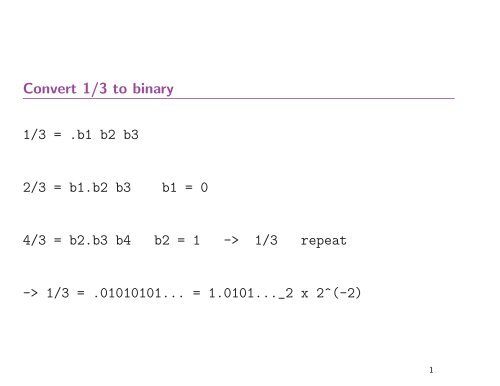Binary/Decimal Approximation
Binary/Decimal Approximation Binary/Decimal Approximation
Convert 1/3 to binary 1/3 = .b1 b2 b3 2/3 = b1.b2 b3 b1 = 0 4/3 = b2.b3 b4 b2 = 1 -> 1/3 repeat -> 1/3 = .01010101... = 1.0101..._2 x 2^(-2) 1
- Page 2 and 3: More Explanation on Binary/Decimal
Convert 1/3 to binary<br />
1/3 = .b1 b2 b3<br />
2/3 = b1.b2 b3 b1 = 0<br />
4/3 = b2.b3 b4 b2 = 1 -> 1/3 repeat<br />
-> 1/3 = .01010101... = 1.0101..._2 x 2^(-2)<br />
1
More Explanation on <strong>Binary</strong>/<strong>Decimal</strong> <strong>Approximation</strong><br />
The range of values from approximately 0.000641 to 0.000702<br />
would all get the same representation to four binary digit<br />
precision.<br />
To see this, note that 1.325 × 2 −11 = .0006926 is in the<br />
given range. The binary representation of this number is<br />
0.00000000001011 2 .<br />
Any number with a binary representation between<br />
0.000000000010101000... 2 and<br />
0.000000000010111000... 2 will be approximated by<br />
2
0.00000000001011 2 . In other words, any number within<br />
2 −15 of 0.00000000001011 2 will be approximated by<br />
0.00000000001011 2 .<br />
To see what these numbers are in decimal form, we can do<br />
the computation in R:<br />
> 2^(-11)*(1.375) + 2^(-15)<br />
[1] 0.0007019043<br />
> 2^(-11)*(1.375) - 2^(-15)<br />
[1] 0.0006408691<br />
Thus, everything within the range .000641 and .0007019 will<br />
be approximated by the same 4 digit binary number.



